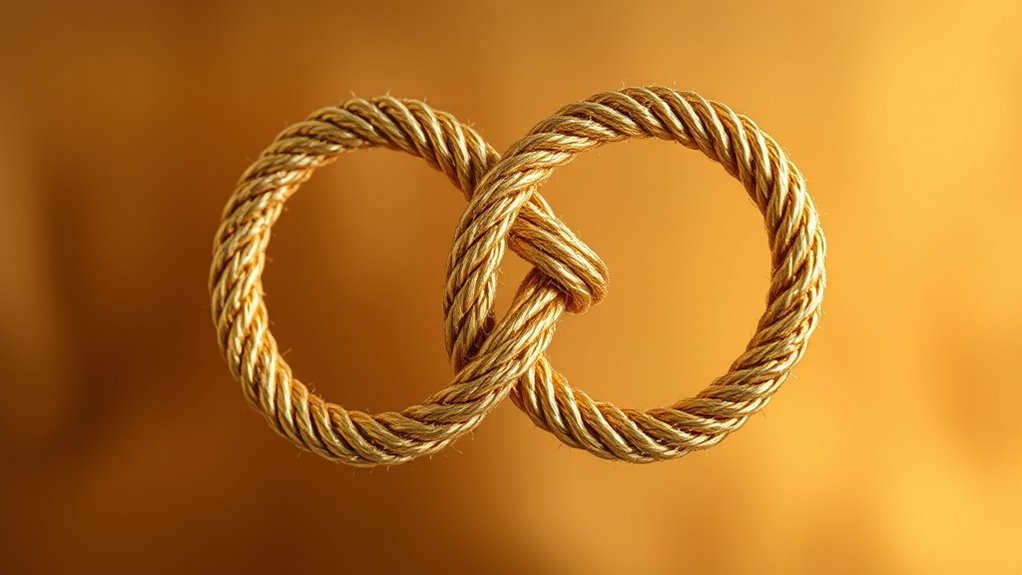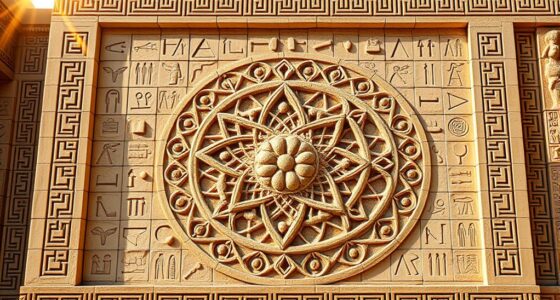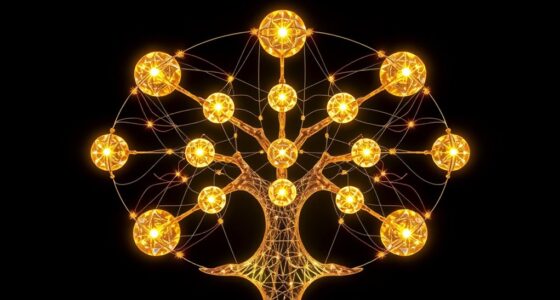The infinity knot symbolizes eternal interconnectedness, representing concepts like life, death, and rebirth across various spiritual traditions. In Buddhism and Hinduism, it signifies the cyclical nature of existence and spiritual continuity, while Celtic designs emphasize endless life and soul unity. You can see it as a reminder of life’s ongoing flow and your interconnectedness with everything. If you keep exploring, you’ll discover even deeper meanings and cultural significance behind this powerful symbol.
Key Takeaways
- The infinity knot symbolizes eternity, interconnectedness, and the cycle of life, prevalent in Buddhist, Hindu, and Celtic traditions.
- It represents the cyclical nature of existence, emphasizing life, death, rebirth, and impermanence across spiritual contexts.
- Used in meditation, it fosters spiritual harmony, awareness of interconnectedness, and acceptance of life’s ongoing flow.
- In cultural artifacts like Tibetan mandalas and Celtic art, it signifies eternal life, spiritual continuity, and unity.
- The infinity knot serves as a protective charm and personal reminder of love, faith, and the infinite bonds that connect all beings.

Have you ever noticed the symbol of the infinity knot, a continuous loop with no beginning or end? This design isn’t just a simple decoration; it carries profound meaning across various cultures and spiritual traditions. You might see it woven into jewelry, embroidered on clothing, or depicted in religious artwork, but its true significance goes much deeper. The infinity knot embodies meditative symbolism, representing eternity, interconnectedness, and the endless cycle of life. When you focus on its endless loop, it serves as a reminder that everything is linked, and nothing truly ends—only transforms.
In many traditions, the infinity knot symbolizes spiritual continuity and the unity of opposites. For example, in Buddhism and Hinduism, it’s known as the endless knot or eternal knot. Here, it signifies the interconnectedness of all things—past, present, and future—and highlights the cyclical nature of existence. Practitioners may meditate on this symbol to deepen their understanding of impermanence and to cultivate a sense of spiritual harmony. It’s a visual representation of the meditative journey, helping you to focus on the ongoing flow of life and the interconnected web of all beings.
Culturally, the infinity knot holds significance beyond its spiritual meanings. In Tibetan art, it’s often seen in intricate mandalas and religious relics, symbolizing the eternal cycle of life, death, and rebirth. In Celtic traditions, similar designs appear in knotwork that emphasizes the endless nature of life and the continuity of the soul. These symbols serve not only as protective charms but also as cultural markers that connect communities through shared beliefs about eternity and unity. Recognizing symbolic meaning can deepen your appreciation for its role in spiritual and cultural contexts.
You can incorporate the infinity knot into your own spiritual practice or daily life as a symbol of resilience and interconnectedness. Its meditative symbolism encourages you to embrace the ongoing flow of life, recognizing that even in moments of chaos or change, everything remains connected. The cultural significance behind the infinity knot enriches its meaning, reminding you that your journey is part of a larger, endless cycle. Whether you wear it as jewelry or meditate upon its form, the infinity knot invites you to reflect on the infinite possibilities within your life and the eternal bonds that tie us all together. It’s a powerful reminder that some things—like love, faith, and connection—are truly infinite.
Frequently Asked Questions
What Are the Historical Origins of the Infinity Knot?
The origins of the infinity knot trace back to ancient meditative symbolism, where it represents eternity and interconnectedness. You’ll find it across various cultures due to cultural diffusion, especially in Tibetan Buddhism, Chinese art, and Celtic traditions. These societies adopted and adapted the symbol, emphasizing spiritual continuity and unity. Its enduring presence highlights its significance in conveying the idea of endless cycles and interconnectedness across different spiritual practices.
How Is the Infinity Knot Used in Modern Spiritual Practices?
They say “what’s old is new again,” and the infinity knot is no exception. Today, you see it in meditation symbolism, reminding you of eternity and interconnectedness, and in modern jewelry, where it symbolizes limitless love and unity. You can wear it to stay connected to spiritual roots or use it as a calming focus during meditation. Its timeless design continues to inspire and ground you in contemporary spiritual practices.
Are There Specific Colors Associated With the Infinity Knot Symbolism?
You might notice that color symbolism plays a role in how the infinity knot is viewed, with different hues conveying specific meanings. For example, gold often represents enlightenment, while blue symbolizes calmness. Cultural variations influence these color associations, so in some traditions, red signifies energy. When exploring the infinity knot, consider how these diverse color meanings deepen its spiritual significance across different cultures and practices.
Can the Infinity Knot Be Found in Ancient Art Outside Spiritual Contexts?
You might find the infinity knot in ancient jewelry and art outside spiritual contexts, where it often symbolizes eternity or interconnectedness. Cultural symbolism plays a big role, as many civilizations incorporated it into their designs to convey unity, continuity, or protection. So, if you explore ancient artifacts, keep an eye out for this motif beyond religious or spiritual settings, recognizing its broad significance across different cultures and eras.
What Are Common Misconceptions About the Infinity Knot’s Meaning?
You might think the infinity knot’s symbolism is universal, but there are many misconceptions. People often assume it always represents eternity or interconnectedness, yet cultural variations influence its meaning. In some traditions, it symbolizes protection, while in others, it signifies unity or the cyclical nature of life. Don’t overlook these cultural differences; they shape how the infinity knot’s symbolism is understood and used across contexts.
Conclusion
You might be surprised to learn that the infinity knot appears in over 50 different spiritual traditions worldwide, symbolizing eternity and interconnectedness. This universal motif reminds you that life’s cycle is continuous, blending past, present, and future. Recognizing its widespread presence can deepen your appreciation for shared spiritual symbols across cultures. Embrace the endless loop as a reflection of your own journey—ever-evolving, interconnected, and infinite in possibilities.











